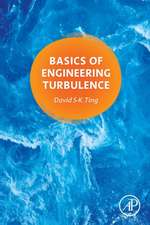Transition, Turbulence, and Noise: Theory and Applications for Scientists and Engineers: The Springer International Series in Engineering and Computer Science, cartea 282
Autor Reda R. Mankbadien Limba Engleză Hardback – 30 sep 1994
| Toate formatele și edițiile | Preț | Express |
|---|---|---|
| Paperback (1) | 949.42 lei 6-8 săpt. | |
| Springer Us – 14 mar 2014 | 949.42 lei 6-8 săpt. | |
| Hardback (1) | 955.56 lei 6-8 săpt. | |
| Springer Us – 30 sep 1994 | 955.56 lei 6-8 săpt. |
Din seria The Springer International Series in Engineering and Computer Science
- 24%
 Preț: 1041.98 lei
Preț: 1041.98 lei - 20%
 Preț: 643.50 lei
Preț: 643.50 lei - 18%
 Preț: 1225.62 lei
Preț: 1225.62 lei - 18%
 Preț: 965.02 lei
Preț: 965.02 lei - 20%
 Preț: 646.12 lei
Preț: 646.12 lei - 18%
 Preț: 948.79 lei
Preț: 948.79 lei - 20%
 Preț: 646.62 lei
Preț: 646.62 lei - 15%
 Preț: 637.46 lei
Preț: 637.46 lei - 20%
 Preț: 643.83 lei
Preț: 643.83 lei - 18%
 Preț: 949.23 lei
Preț: 949.23 lei - 20%
 Preț: 644.48 lei
Preț: 644.48 lei - 20%
 Preț: 994.92 lei
Preț: 994.92 lei - 20%
 Preț: 645.97 lei
Preț: 645.97 lei - 18%
 Preț: 946.87 lei
Preț: 946.87 lei - 20%
 Preț: 995.57 lei
Preț: 995.57 lei - 18%
 Preț: 956.99 lei
Preț: 956.99 lei - 20%
 Preț: 644.98 lei
Preț: 644.98 lei - 15%
 Preț: 649.54 lei
Preț: 649.54 lei - 18%
 Preț: 950.21 lei
Preț: 950.21 lei - 18%
 Preț: 1221.38 lei
Preț: 1221.38 lei - 18%
 Preț: 957.62 lei
Preț: 957.62 lei - 15%
 Preț: 643.99 lei
Preț: 643.99 lei - 18%
 Preț: 948.47 lei
Preț: 948.47 lei - 18%
 Preț: 947.35 lei
Preț: 947.35 lei - 20%
 Preț: 1284.65 lei
Preț: 1284.65 lei - 20%
 Preț: 1628.31 lei
Preț: 1628.31 lei - 20%
 Preț: 1285.78 lei
Preț: 1285.78 lei
Preț: 955.56 lei
Preț vechi: 1165.32 lei
-18% Nou
Puncte Express: 1433
Preț estimativ în valută:
182.90€ • 198.74$ • 153.74£
182.90€ • 198.74$ • 153.74£
Carte tipărită la comandă
Livrare economică 22 aprilie-06 mai
Preluare comenzi: 021 569.72.76
Specificații
ISBN-13: 9780792394815
ISBN-10: 079239481X
Pagini: 381
Ilustrații: XVI, 381 p. 3 illus.
Dimensiuni: 155 x 235 x 22 mm
Greutate: 0.74 kg
Ediția:1994
Editura: Springer Us
Colecția Springer
Seria The Springer International Series in Engineering and Computer Science
Locul publicării:New York, NY, United States
ISBN-10: 079239481X
Pagini: 381
Ilustrații: XVI, 381 p. 3 illus.
Dimensiuni: 155 x 235 x 22 mm
Greutate: 0.74 kg
Ediția:1994
Editura: Springer Us
Colecția Springer
Seria The Springer International Series in Engineering and Computer Science
Locul publicării:New York, NY, United States
Public țintă
ResearchCuprins
1. Introduction.- 1.0. Nomenclature.- 1.1. Background.- 1.2. Types of Turbulent Flow.- 1.3. Characteristics of Turbulent Flows.- 1.4. Sources of Turbulence.- 1.5. Reynolds Experiment.- 1.6. Hydrodynamic Instability Theory.- 1.7. Transition Structures.- 1.8. Velocities in Turbulence: Reynolds Decomposition.- 1.9. Kinetic Energy of Turbulence.- 1.10. Turbulence Measurement.- References.- 2. Linear Stability Theory.- 2.0. Nomenclature.- 2.1. Introduction.- 2.2. Linear Stability Equations.- 2.3. Flat-Plate Boundary-Layer Instability.- 2.4. Linear Instability of Axisymmetric Jet.- 2.5 Compressibility Effects.- References.- 3. Later Stages of Boundary-Layer Transition.- 3.0. Nomenclature.- 3 1. Introduction.- 3.2. Experimental Observations on Subharmonic Transition.- 3.3. Linear Secondary Instability Theory.- 3.4. Parabolized Stability Equations.- 3.5. Critical-Layer Theory.- 3.6. Resonant Triad Interaction.- 3.7. Nonlinear Mechanisms.- References.- 4. Governing Equations and Structure of Turbulent Flows.- 4.0. Nomenclature.- 4.1. Introduction.- 4.2. Governing Equations.- 4.3. Structure of Turbulent Flows.- References.- 5. Computations of Incompressible Flows Using Turbulence Models.- 5.0. Nomenclature.- 5.1. Introduction.- 5.2. Simple Algebraic or Zero-Equation Models.- 5.3. One-Equation Models.- 5.4. Two-Equation Models.- 5.5. Reynolds-Stress Models.- 5.6. Numerical Solution of Navier-Stokes Equations.- References.- 6. Coherent Structures in Turbulent Jets.- 6.0. Nomenclature.- 6.1. Introduction.- 6.2. Hydrodynamic Stability Theory and Coherent Structures.- 6.3. Dynamics of Energy Transfer.- 6.4. Nonlinear Development of Amplitude.- 6.5. Development of Single-Frequency Coherent Mode.- 6.6. Fundamental-Subharmonic Interaction and Vortex Pairing.- 6.7. Reversal of Reynolds Stresses.- 6.8. Effect of Initial Phase Angle.- 6.9. Conditions for Resonance Interaction.- 6.10. Multifrequency Excited Jets.- 6.11. Modulation of Spreading Rate.- 6.12. Turbulence Enhancement or Suppression.- 6.13. Three-Dimensional Effects.- References.- 7. Unsteady, Wall-Bounded Turbulent Flows.- 7.0. Nomenclature.- 7.1. Introduction.- 7.2. Phase-Averaged Equations.- 7.3. Quasi-Steady k-? Turbulence Model.- 7.4. Oscillating Flow Between Two Parallel Plates.- 7.5. Unsteady Rotor-Stator Interactions.- 7.6. Oscillating Heat Transfer in Reattaching Flows.- 7.7. Validity of Quasi-Steady Turbulence Models.- 7.8. Rapid-Distortion Approach.- References.- 8. Direct and Large-Eddy Simulations.- 8.0. Nomenclature.- 8.1. Direct Numerical Simulations.- 8.2. Resolution Requirements for DNS.- 8.3. Outlook for DNS.- 8.4. Large-Eddy Simulations.- 8.5. Filtering.- 8.6. Filtered Equations.- 8.7. Modelling Subgrid-Scale Turbulence.- 8.8. Discretization.- 8.9. Boundary Conditions.- 8.10. Application to Supersonic Jets.- References.- 9. Turbulence-Generated Noise.- 9.0. Nomenclature.- 9.1. Introduction.- 9.2. Prediction of Sound Source in Turbulent Flows.- 9.3. Analytical Approaches to Sound Propagation.- 9.4. Computational Aero-Acoustics.- References.- Exercises.









